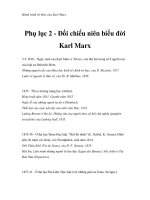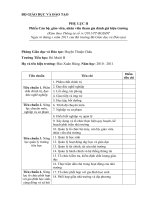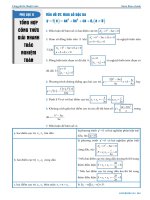Phụ lục 2 nhóm
Bạn đang xem bản rút gọn của tài liệu. Xem và tải ngay bản đầy đủ của tài liệu tại đây (173.73 KB, 5 trang )
Phụ lục 2: HƯỚNG DẪN DỰ GIỜ VÀ RÚT KINH NGHIỆM GIỜ DẠY
(Ghi vào sổ KTSP VÀ TTSP) (*)
Thứ ... ngày .... tháng .... năm ......
Giáo viên (SV) dạy: ............................. Tiết thứ: ........... Lớp: ..........................
Môn học: .............................................................................................................
Bài dạy: ................................................................................................................
Họ tên số SV đã dự: .............................................................................................
Họ tên giáo viên ĐHSP (nếu có) và trường thực tập dự: .....................................
...............................................................................................................................
I. Chuẩn bị trước khi dự giờ:
ĐỀ CƯƠNG BÀI DẠY
1.
LESSON PLAN
2.
English 10
Unit 3: Music
Lesson 1: Getting started Time: 45 minutes3.
Student’s level: 10th grader (CEFR: A2, B1-) 4.
STAGE 1: DESIRED OBJECTIVES
A. Objectives
By the end of the lesson, students will be able to:
1. Understand vocabulary related to the topic Music
2. Identify different appliances through scanning and skimming a passage about a talented
artist
3. Students can use vocabulary to talk about their favorite songs
4. Show their love and be aware of the important role of music in our life.
B. Language Focus: talented, artist, musical instrument, trumpet, upload, social media, music
awards.
Key terms: Key grammar/ structure: Compound sentences
C. Instructional resources
- Grade 10 textbook, Unit 3, Getting started
- 3 sound recordings of three musical instruments
- 2 photos of 2 famous singers
- Computer & projector
STAGE 2 – ASSESSMENT EVIDENCE
Performance Tasks
1. Learn new words about the music
Performance
products
Teacher and
student
2. . Read the passage and do comprehension
Student’s answer
tasks.
3. Work in groups and discuss about your
favourite song
Group discussion
Assessment
tools
Observation
Answer key,
Observation
Observation
Peer correction
4. Show their love and be aware of
the important role of music in our
life.
Student’s talk
Questions &
answers
Observation
Peer correction,
Reflection,
report
STAGE 3 – LEARNING PLAN/ LEARNING EXPERIENCES
Activity 1: Warm-up
1 - Ask students to listen to the sounds of three musical instruments.
- Ask students the following questions about sounds and elicit their answers.
a. Tell me the name of musical instruments? (guitar, piano, saxophone)
2 - Ask students to observe 2 pictures of two famous singers
- Ask students the following questions about pictures and elicit their answers
a.Who are they?
b.Do you know any of his/her famous songs?
- Students work in groups and answer the question.
- Call on some students to share their opinions, and encourage different viewpoints.
- Lead students to the new lesson.
Activity 2: Presentation
1. Listen and read:
- Before listening, ask students look at the picture (p.28) and answer the questions
+ Where are they? (at home/ in the living room)
+ Who is the boy? (a singer)
+ What are they doing? (The boy is singing on the stage. The girls are watching a
live programme and cheering.)
- Give students the recording and ask them to listen, read along, and imitate the intonation
- Ask students to underline new vocabulary
2. Vocabulary
- Ask students to look at the reading passage on page 28, 29.
- Elicit the meanings of the vocabulary in the text.
+ talented /ˈtælən.tɪd/: tài năng
+ artist /ˈɑː.tɪst/: nghệ sĩ
+ musical instrument /ˈmjuː.zɪ.kəl ˈɪn.strə.mənt/: nhạc cụ
+ upload /ʌpˈləʊd/: tải lên
+ social media /ˌsəʊ.ʃəl ˈmiː.di.ə/: mạng xã hội
+ award /əˈwɔːd/: giải thưởng
+ music awards /ˈmjuː.zɪk əˈwɔːd / các giải thưởng âm nhạc
- Check student’s pronunciation
- Check students' understanding using the “Rub out and remember” technique.
Activity 3: Practice
1. Answer the following questions.
- Analyze and understand the exact task requirements
- Read the question and underline the keywords in the question
- Ask students to scan the conversation for keywords, locate the part that contains information
for each question.
- Apply skimming skills to exercise
- Give feedback by asking students to answer on the board. In addition, ask students to practice
asking and answering questions.
- Check student’s answers.
Key:
1. They are talking about a young pop singer.
2. He is good at writing music and playing many musical instruments.
3. His cover song videos made him popular.
2. Find words or phrases
- Analyze and understand the exact task requirements
- Explain the meaning of the given phrases
- Ask students to guess some possible answers
- Ask students to work in groups, skim through the text to find answers
- Give feedback by asking students to answer on the board
- Check student’s answers.
Key: 1. Pop; 2. Grammy, Billboard Music and Teen Choice Awards; 3. Piano, drums, guitar, and
trumpet.
3. Match
- Analyze and understand the exact task requirements
- Ask students to work in pairs, skim through the article to match the two parts to make
complete sentences
- Provide feedback by asking students to read complete sentences aloud and translate the
meaning
- Check student’s answers
Activity 4: Production
- Q&A (conversation) with students related to music topics
- Provide some questions for students to answer:
+ Do you often listen to music?
+ When do you usually listen to music?
+ What is your favorite song? What kind of music is it?
+ What benefits does listening to music bring you?
Wrap-up & Assignments
- Ask students to answer the following questions:
1. What did you learn from the lesson today?
2. What’re the core values of the lesson?
(Show their love and be aware of the important role of music in our life)
- Remind students to do exercises in the workbook (Unit 3- lesson 1: getting started) and to prepare
for the next lesson (Unit 3: Languge).
II. Công việc của SV dự giờ:
Quan sát và ghi những nhận xét của mình theo mẫu sau:
1. Việc chuẩn bị của giáo viên và học sinh: (cần quan sát quá trình dạy học và những điều kiện
đảm bảo cho giờ dạy)
- Ý nghĩa giáo dục (qua mục tiêu của bài học).
- Quá trình hình thành bài dạy, kỹ năng, kỹ sảo của giáo viên.
- Dàn bài và bảng tóm tắt bài (thể hiện hợp lý không...).
- Nội dung và phương pháp giảng dạy, phương tiện dạy học.
- Tính sáng tạo của giáo viên trong giờ dạy.
2. Bắt đầu giờ học, nhận xét rút kinh nghiệm các phần:
- Ổn định tổ chức, kiểm tra bài cũ, phương pháp kiểm tra.
- Việc chuẩn bị bài của học sinh.
- Nhận xét và uốn nắn đánh giá của cho điểm.
3. Trình bày bài mới:
* Hoạt động dạy của giáo viên:
- Kiến thức, nội dung, kỹ năng đạt được.
- Tính khoa học, hệ thống, kế thừa, sáng tạo của giáo viên.
- Phương pháp sư phạm: thể hiện phương pháp đặc trưng môn học, tiết học, tác động tích
cực đến học sinh.
- Thiết kế bài dạy hợp lý; vai trò của giáo viên trong tiết dạy; chữ viết, trình bày bảng, sử
dụng và kết hợp tốt các phương tiện thiết bị dạy học phù hợp với nội dung kiến thức bài dạy.
- Thái độ, phong cách, cử chỉ, lời nói, ngơn ngữ của giáo viên.
- Phương pháp củng cố bài của giáo viên.
* Hoạt động của học sinh:
- Tinh thần, thái độ, hứng thú.
- Việc làm, các hoạt động của người học.
* Kết quả tiết dạy (dựa vào quan hệ qua lại giữa giáo viên và học sinh):
- Đã thực hiện được mức độ nào của mục tiêu bài dạy.
- Kỹ năng, kiến thức cơ bản được hình thành.
4. Bài tập về nhà và kết thúc bài học:
- Khối lượng bài tập và nhiệm vụ giao cho học sinh hợp lý chưa.
- Phương pháp hướng dẫn bài về nhà.
- Khơng khí tổ chức lớp học phút cuối,
III. Những kết luận:
- Ưu nhược điểm chính.
- Thành công của bài dạy.
- Bài học kinh nghiệm.
IV. Các bước rút kinh nghiệm dự giờ:
Công việc này thực hiện ngay sau mỗi giờ dạy (khơng để có nhiều giờ mới tổ chức rút
kinh nghiệm), mời giáo viên (người dạy), hoặc giảng viên sư phạm, tất cả SV có dự giờ cùng rút
kinh nghiệm.
Các bước được tiến hành như sau:
1. Người dạy trình bày lại mục đích, u cầu, cơng tác chuẩn bị, thuận lợi và khó khăn
của bản thân khi soạn và khi dạy, tự nhận xét ưu, khuyết điểm bài dạy, nguyên nhân thành công
hay thất bại và những phương hướng cải tiến để dạy tốt trong các giờ tiếp theo; sơ bộ tự đánh giá
kết quả.
2. SV dựa vào tư liệu đã ghi chép được trong quá trình dự giờ phát biểu ý kiến từng phần,
nhận xét ưu, khuyết điểm về nội dung và phương pháp giảng dạy, góp ý kiến để khắc phục và cải
tiến.
3. Giáo viên hoặc nhóm trưởng tổng kết các ý kiến góp ý, nêu những kết luận, khái quát
ưu nhược điểm của giờ giảng, rút bài học kinh nghiệm. SV ghi vào sổ nhật ký thực tập những kết
luận đó. (Đối với Ngành GD Mầm non, đối chiếu các yêu cầu trong phiếu đánh giá tiết dạy theo
mẫu của Vụ Giáo dục Mầm non đã ban hành để tổ chức rút kinh nghiệm giờ dạy).
NHẬN XÉT CỦA GVHD
Lê Thị Nhàn
SINH VIÊN









